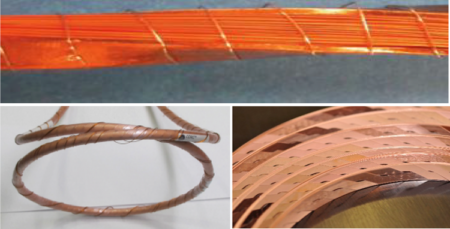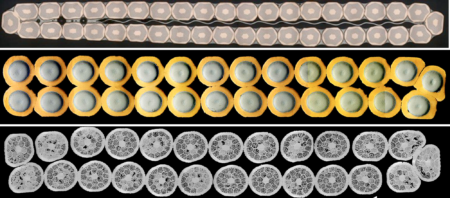Conductor development is a critical component of the program vital to Magnet Program needs. The role of conductor procurement and research and development (CPRD) is twofold: 1) procurement of “workhorse” conductors to support magnet R&D and 2) further industrial development of more advanced conductors relevant to the MDP. Key elements of CPRD include definition of achievable goals and milestones for:
- Determining the performance limits of Nb3Sn and high-temperature superconductor (HTS) conductors.
- Understanding uniformity and reliability, especially of HTS conductors.
- Understanding of future conductor scalability and cost.
- Evaluating factors critical for eventual worldwide capacity ramp-up for future projects so as to minimize start-up costs and allow more competition.
Directions and Deliverables
Making 16 T dipoles is a challenge to both magnet and conductor technology. In the immediate future it will drive CPRD to considering Nb3Sn conductors beyond the limits of present production, which are approximately 1500 A/mm2 at 15 T and 4.2 K.1, 2 New R&D targets for critical current density of 1500 and 2200 A/mm2 at 16 T at 4.2 and 1.9 K will require either pushing to their limits our understanding of how to better manufacture and optimize the reaction of present restack rod process (RRP) or particle in tube (PIT) Nb3Sn or introducing additional strong pinning (e.g., ZrO2 artificial pinning center ideas) into such conductors.
 Click for larger version |
 Click for larger version |
||
| Top: Twisted tape-stack cable (courtesy of Dr. Makoto Takayasu of Massachusetts Institute of Technology). Above left: ReBCO conductor-on-round-core (CORC) cable (courtesy of Dr. Danko van der Laan of Advanced Conductor Technologies LLC). Above right: ReBCO Roebel cable made from the Bruker ReBCO tapes for the EuCARD2 project (courtesy of Dr. Anna Kario of Karlsruhe Institute of Technology). | Right: Strands of three kinds of wires made into the “Rutherford-style” keystoned cable generally used in accelerator magnets. Above, top to bottom: Cross sections of keystoned 40-strand (0.7 mm) Nb3Sn Rutherford cable with an 11 mm wide and 25 mm thick stainless steel core; 27-strand (1 mm) Nb3Al rectangular cable; 25-strand (0.8 mm) Bi-2212 rectangular cable. (All images courtesy Fermilab.) | ||
At present, the capability for further development of Nb3Sn is unclear and most effort is within the university and SBIR programs. Depending on progress there, such ideas could be brought into CPRD as they mature and show capability of being made into suitable magnet-length conductors. Especially as the magnet R&D program better develops an understanding of the margins required for avoiding or minimizing magnet training, more targeted programs on Bi-2212 and REBCO strand and cable development will be developed. At present the focus is on first defining and optimizing strand performance and then demonstration of 10 kA class cables that can be used for HTS dipole insert magnets.
The research and development purpose of CPRD is to anticipate future magnet development needs including both LTS and HTS wires and cables. Conductor development leads magnet development by 5 years or more and CPRD must also envision conductor needs 10 to 20 years out, which could be conductors for magnets beyond the capability of Nb3Sn, or for magnets that do not require liquid helium, since helium is likely to become increasingly more expensive.
Research emphasizes the present industrially produced cuprate high temperature superconductors Bi-2212 and REBCO3 that can be cabled. Our CPRD efforts will strive to maintain a carefully balanced portfolio, while also emphasizing conductor manufacturing. Importantly, CPRD is intended to support conductor R&D when other sources of research support, such as SBIR grants, cannot be used. This permits the suppliers with the highest level of manufacturing capability to request and possibly receive R&D support.
The procurement responsibility of CPRD is to supply the MDP with production-quality conductors for the cables required for experimental magnets. The R&D responsibility of CPRD is to facilitate the achievement of the aforementioned goals and milestones. If you have activities to propose, please contact the committee at USMDP_CPRD@lbl.gov.
CPRD Advisory Committee
 Dr. Ian Pong Chair Lawrence Berkeley National Laboratory ipong@lbl.gov |
 Prof. Lance Cooley Past Chair National High Magnetic Field Laboratory, Florida State University ldcooley@asc.magnet.fsu.edu |
|||
| Board Members | ||||||

Prof. Matt Jewell |

Prof. David Larbalestier |

Dr. Xingchen Xu |

Vladimir Matias |
References
1 E. Barzi, A.V. Zlobin, “Research and Development of Nb3Sn Wires and Cables for High-Field Accelerator Magnets,” IEEE Transactions on Nuclear Science 63, 2 (April 2016), pp. 783-803.
2 D.R. Dietderich and A. Godeke, “Nb3Sn Research and Development in the USA — Wires and Cables”, Cryogenics 48, 7 (2008), p. 331.
3 Bi-2212 stands for the silver-sheathed round wire superconductor Bi2Sr2CaCu2O8+x, and REBCO describes thin film superconductors in tape form based on the formula (RE)Ba2Cu3O7-δ, where RE represents a rare-earth element such as yttrium.
